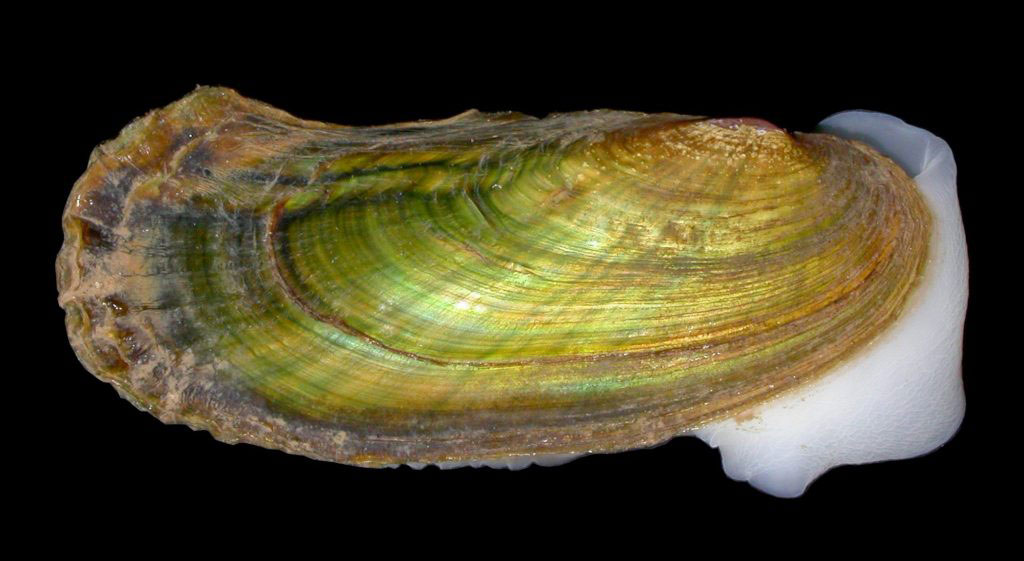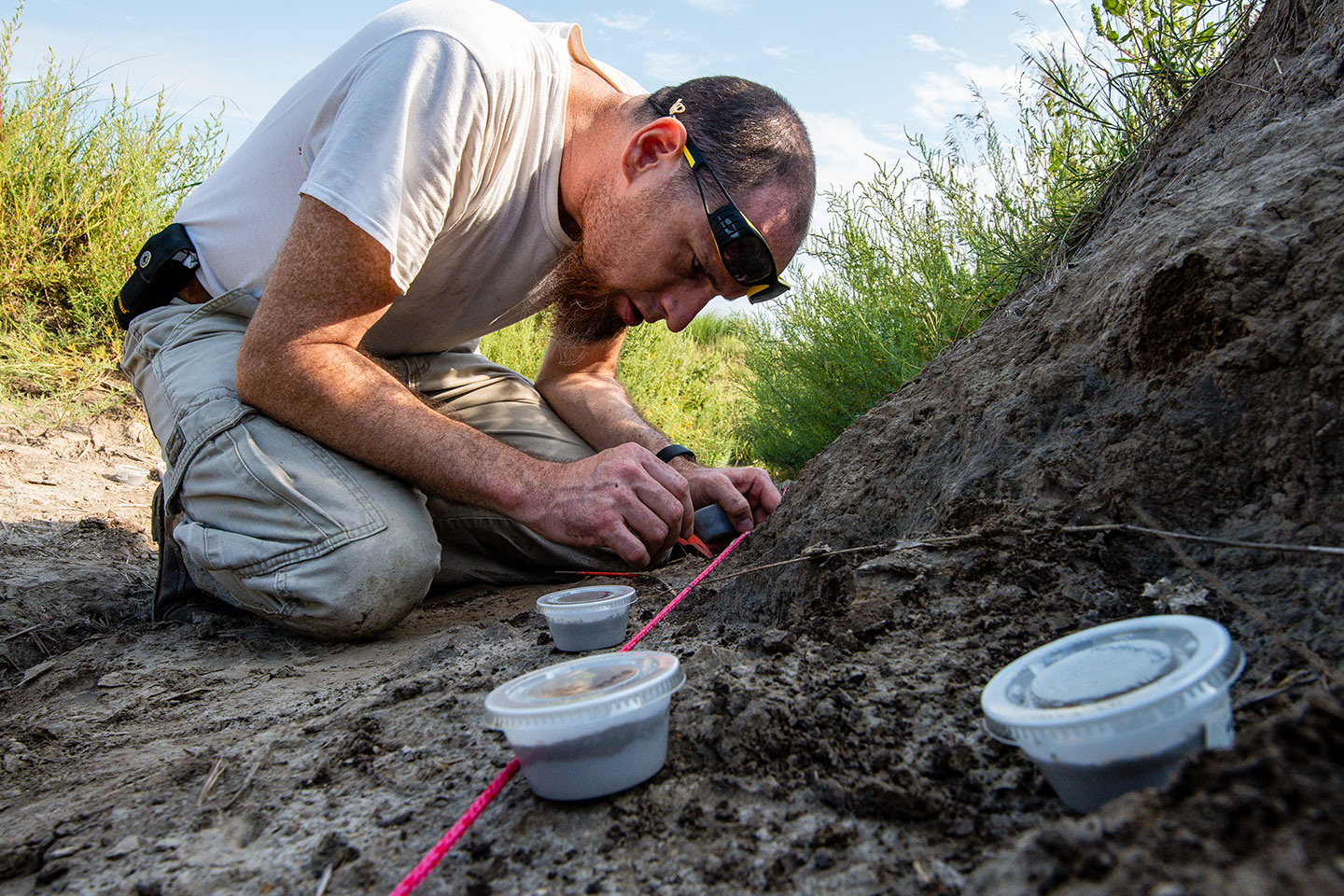Scaleshell mussel
Status: Endangered

The Scaleshell Mussel is a small freshwater mussel. It is oval with a thin outer shell that is smooth and yellow-green to brown in color with numerous faint green rays. The outer shell is thin and in females looks like scales (hence the name).
The interior of the shell is faint pink to purple in color and is iridescent like the inside of an abalone shell. The Scaleshell Mussel reaches lengths of 1-4 inches. The anterior end is rounded while the posterior end comes to a slight, rounded point.
Scaleshell mussels are important in an ecosystem because of their role in filtering or cleaning the water as well as their role as prey for numerous species. Additionally, they are known as an indicator species – their presence in a stream or river indicates good water quality.
The Scaleshell mussel was officially added to the United States Threatened and Endangered species list on October 9, 2001.
Range
Historically, the Scaleshell Mussel was found across much of the eastern United States. Today, it is found in 14 isolated populations.
In Nebraska, it is found in a small area north of Highway 20 from Yankton to South Sioux City.
Habitat
Scaleshell Mussels are most likely to be found in clear, fast moving streams and rivers with gravel or sand substrates (bottoms). Within streams and rivers, they can be found in the riffles or fast moving currents.
They burrow themselves into the gravel or sand with only a small portion of their shell visible. They require good water quality.
Reproduction
Reproduction for mussels is complicated and involves several steps. Males release sperm into the open water where it is taken up by the females. Eggs are fertilized inside the female. Once fertilized, eggs move into the water tubes of the female’s gills where the eggs develop into glochidia (larvae). Glochidia may remain in the female’s water tubes for up to 11 months.
The glochidia are then released into the open water where they must attach to the gills of a host fish where they will develop into a juvenile mussel. The Freshwater Drum is most often used as a host fish. Upon attaching to the host fish, the glochidia is encapsulated by the host fish’s epithelial cells. Within a few days to a few weeks, the glochidia will develop into juvenile mussels. At this point, they slough off the host fish and are free-living organisms. Juvenile fish are often found burrowed into the substrate of the stream or river.
Lifespan for this species is not known, but age can be determined by counting the annual rings on the outer shell.
Population status
Due to their sedentary lifestyle and their lack of mobility, the population of Scaleshell Mussels is highly impacted by water quality. If water quality deteriorates, the mussels are not able to move rapidly and escape the poor conditions. Issues impacting water quality include increased sedimentation, changes in water temperature and changing water flow patterns. Each of these issues can be caused by human actions including dam construction, poor land management, and increased run-off.
Water quality may also deteriorate due to chemical (pesticide, herbicide, factory and urban) discharge or run-off.
Additionally, the Scaleshell mussel can be greatly impacted by invasive species such as the Zebra mussel which can attach to the Scaleshell mussel and suffocate it.
Although once found in streams and rivers throughout much of the eastern United States, the Scaleshell mussel has seen a 75% reduction in the number of streams where it is present. (55 streams down to 14).
Management and outlook
Current efforts to increase the populations of Scaleshell Mussels include protecting existing natural populations through laws, regulations and inventive programs. Additionally, numerous agencies and organizations – including the Nebraska Game and Parks Commission – are working on artificial propagation with the goal of releasing these individuals into the wild to boost natural populations.
Research is also being conducted to help learn more about the natural history and behavior of this species. With increased knowledge comes better management and recovery.
Significant work is also being done to develop partnerships to help maintain remaining habitat and restore available habitat. Partnerships between government agencies, non-profit organizations, colleges and universities and private land owners are striving for improved water quality and Scaleshell mussel habitat.
Finally, education plays a critical role in the recovery of this species. Through science-based education efforts, more citizens will be aware of their role in ensuring all bodies of water maintain good water quality. Citizens, especially private land owners, also play a role in habitat management.
Conservation help
All citizens play a role in maintaining good water quality conditions. Do not dump chemicals into any drain, storm drain or body of water. When chemical disposal is required, utilize hazardous waste collection sites or events. Additionally, minimizing the application of chemicals to laws and gardens helps ensure only rain is running off the land into rivers, lakes and streams.
Donations to conservation organizations dedicated to working to recover Threatened and Endangered species is also important. Research, habitat restoration and education all require funding.
And, finally, citizens can learn about Nebraska’s Threatened and Endangered species and share their knowledge with others.
References
Michigan Natural Features Inventory. 2007. Rare Species Explorer (Web Application). Accessed Dec 19, 2017.
Leptodea leptodon. NatureServe Explorer: Online Encyclopedia of Life. Accessed December 19, 2017.
Mulcrone, R. 2006. “Leptodea leptodon” (On-line), Animal Diversity Web. Accessed December 19, 2017 at http://animaldiversity.org/accounts/Leptodea_leptodon/
Scaleshell Mussel Fact Sheet. U.S. Fish and Wildlife Service, Upper Midwest Region. September 21, 2016.




